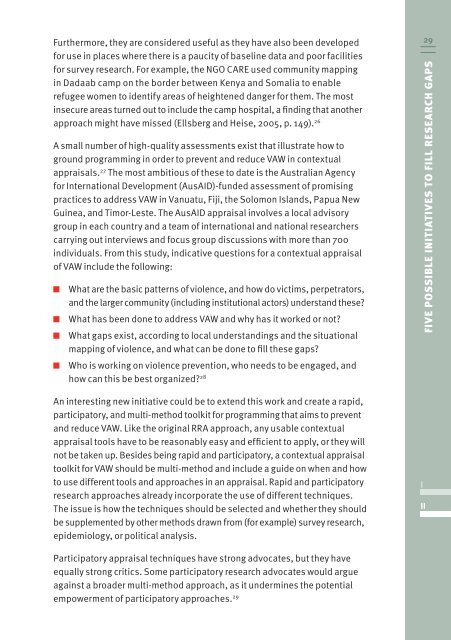Tackling Violence against Women: From Knowledge to Practical
Tackling Violence against Women: From Knowledge to Practical
Tackling Violence against Women: From Knowledge to Practical
Create successful ePaper yourself
Turn your PDF publications into a flip-book with our unique Google optimized e-Paper software.
Furthermore, they are considered useful as they have also been developed<br />
for use in places where there is a paucity of baseline data and poor facilities<br />
for survey research. For example, the NgO CARE used community mapping<br />
in Dadaab camp on the border between kenya and Somalia <strong>to</strong> enable<br />
refugee women <strong>to</strong> identify areas of heightened danger for them. The most<br />
insecure areas turned out <strong>to</strong> include the camp hospital, a finding that another<br />
approach might have missed (Ellsberg and Heise, 2005, p. 149). 26<br />
A small number of high-quality assessments exist that illustrate how <strong>to</strong><br />
ground programming in order <strong>to</strong> prevent and reduce VAw in contextual<br />
appraisals. 27 The most ambitious of these <strong>to</strong> date is the Australian Agency<br />
for International Development (AusAID)-funded assessment of promising<br />
practices <strong>to</strong> address VAw in Vanuatu, Fiji, the Solomon Islands, papua New<br />
guinea, and Timor-Leste. The AusAID appraisal involves a local advisory<br />
group in each country and a team of international and national researchers<br />
carrying out interviews and focus group discussions with more than 700<br />
individuals. <strong>From</strong> this study, indicative questions for a contextual appraisal<br />
of VAw include the following:<br />
what are the basic patterns of violence, and how do victims, perpetra<strong>to</strong>rs,<br />
and the larger community (including institutional ac<strong>to</strong>rs) understand these?<br />
what has been done <strong>to</strong> address VAw and why has it worked or not?<br />
what gaps exist, according <strong>to</strong> local understandings and the situational<br />
mapping of violence, and what can be done <strong>to</strong> fill these gaps?<br />
who is working on violence prevention, who needs <strong>to</strong> be engaged, and<br />
how can this be best organized? 28<br />
An interesting new initiative could be <strong>to</strong> extend this work and create a rapid,<br />
participa<strong>to</strong>ry, and multi-method <strong>to</strong>olkit for programming that aims <strong>to</strong> prevent<br />
and reduce VAw. Like the original RRA approach, any usable contextual<br />
appraisal <strong>to</strong>ols have <strong>to</strong> be reasonably easy and efficient <strong>to</strong> apply, or they will<br />
not be taken up. Besides being rapid and participa<strong>to</strong>ry, a contextual appraisal<br />
<strong>to</strong>olkit for VAw should be multi-method and include a guide on when and how<br />
<strong>to</strong> use different <strong>to</strong>ols and approaches in an appraisal. Rapid and participa<strong>to</strong>ry<br />
research approaches already incorporate the use of different techniques.<br />
The issue is how the techniques should be selected and whether they should<br />
be supplemented by other methods drawn from (for example) survey research,<br />
epidemiology, or political analysis.<br />
participa<strong>to</strong>ry appraisal techniques have strong advocates, but they have<br />
equally strong critics. Some participa<strong>to</strong>ry research advocates would argue<br />
<strong>against</strong> a broader multi-method approach, as it undermines the potential<br />
empowerment of participa<strong>to</strong>ry approaches. 29<br />
29<br />
FiVE PossiBlE iNiTiATiVEs To Fill REsEARcH GAPs<br />
i<br />
ii









